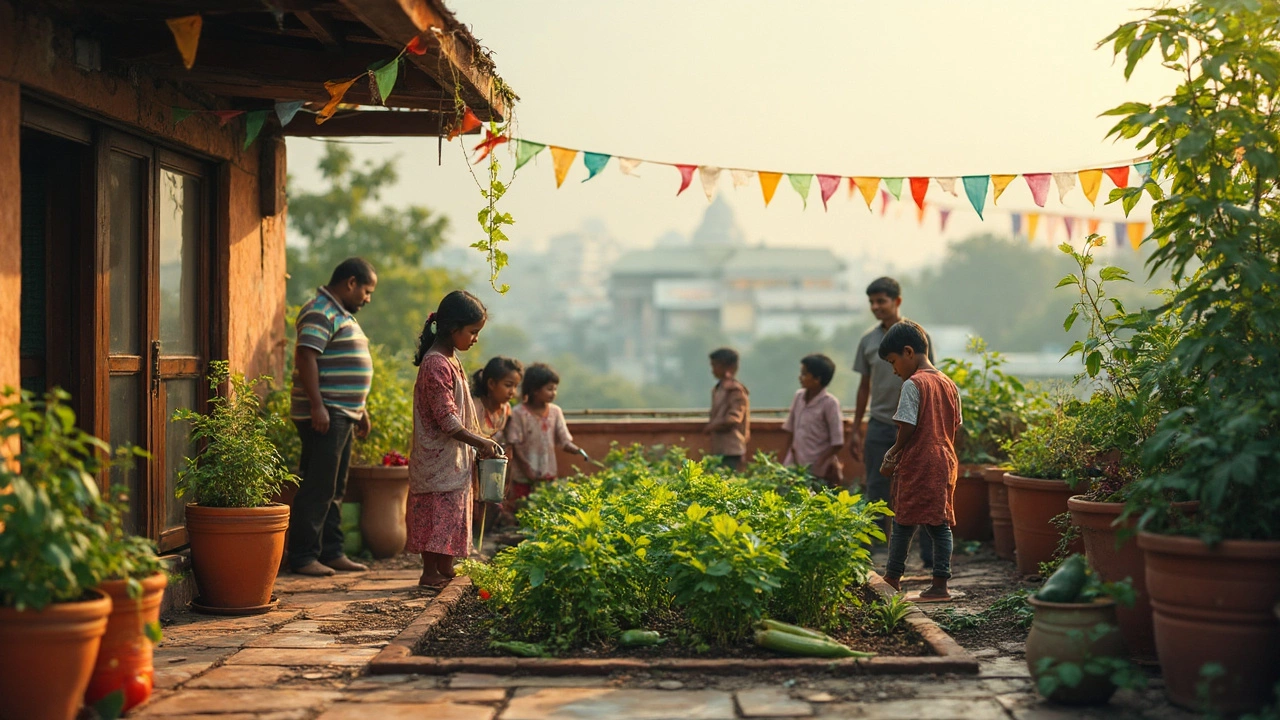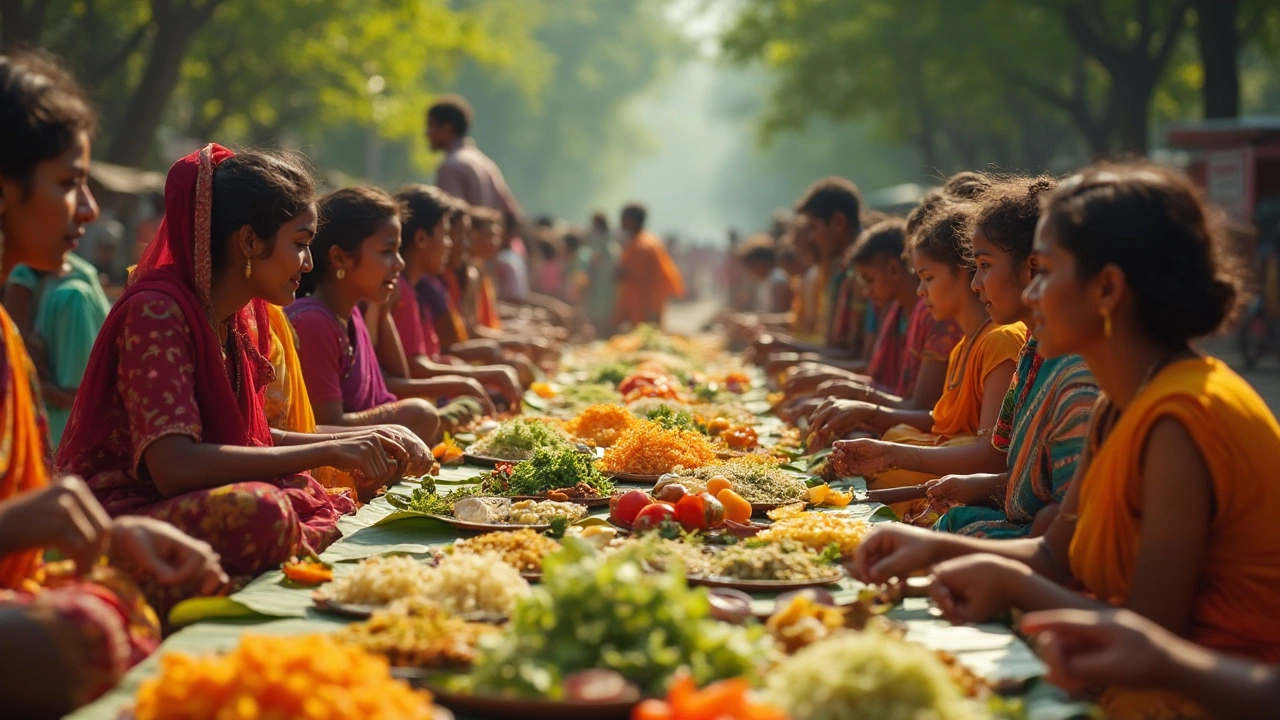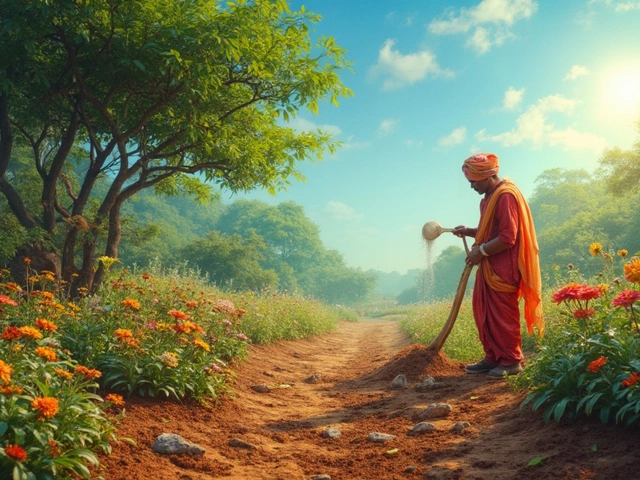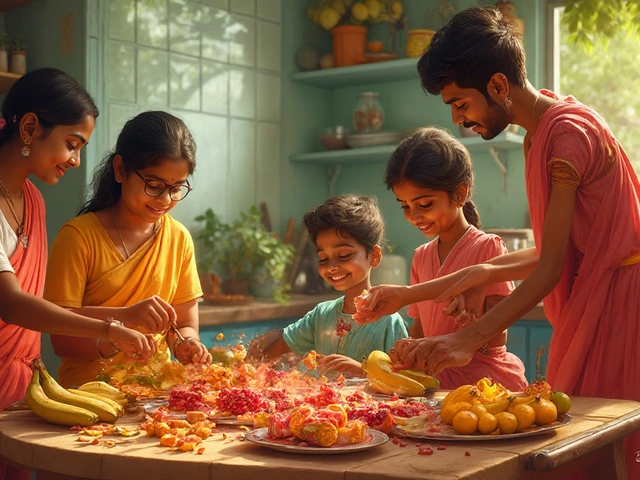It's a wild idea—a whole country where nobody eats meat. No fish, no chicken, not even eggs. You’ve probably heard people say India is the one place that comes close. But is there really any country on the planet that's 100% vegetarian?
Truth is, there’s no country where every single person skips animal products. Even in India, where a big chunk of the population sticks to a plant-based diet for religious and cultural reasons, there’s a mix. Still, India easily leads the world in vegetarian living. If you love gardening, cooking, or just want to understand the real numbers and reasons behind why people eat the way they do, you’re in the right place.
Quick fact: About 30-40% of Indians say they’re vegetarian, according to one of the National Family Health Surveys. That’s way higher than anywhere else. You’ll find entire towns with mostly plant-based menus, ancient traditions that celebrate vegetables, and street food that makes veggies shine.
If you’ve got a green thumb or want fresher meals, growing your own vegetables can be a game changer—especially in India, where the climate helps all sorts of crops thrive. Want to dig deeper into why India stands out, how different regions celebrate veggies, and how you can grow or cook up some of your own? Let’s break it down piece by piece.
- The Vegetarian Country Myth
- Why India Comes Close
- Digging Into India's Plant-Based History
- Vegetarian Habits Across States
- Growing Your Own Veggies in India
- Easy Tips for a Greener Plate
The Vegetarian Country Myth
The idea that an entire country is 100% vegetarian sounds cool, but it’s not real. No nation on Earth is officially or practically all-vegetarian. Even in places where plant-based diets are super popular, you’ll always find people who eat meat, fish, eggs, or other animal stuff. A lot of confusion comes from mixing up a country’s food culture with what every person actually eats.
Take India as the popular example. It has the largest vegetarian population by far, but it’s not an all-vegetarian society. People sometimes say India is a “vegetarian country” because so many avoid meat for religious or cultural reasons. But other countries, like Nepal or Israel, also have big numbers of vegetarians, just not as much as India.
Let’s look at how some countries stack up for vegetarians:
| Country | Vegetarian % (approx.) | Population (millions) |
|---|---|---|
| India | 30-40% | 1400 |
| Israel | 13% | 9 |
| Italy | 6-9% | 59 |
| United Kingdom | 5-7% | 68 |
As the chart shows, no country hits 100%. Even the highest—India—sits around 30-40%. The vegetarian country myth just doesn’t hold up if you check the actual data.
The reasons? Simple: People eat what’s available, what’s affordable, and what fits their beliefs. Trends are changing fast, though. More folks are moving toward plant-based eating, but complete conversion everywhere is nowhere in sight. So, if you hear someone claim there’s a fully vegetarian nation, you can bust that myth with solid numbers.
Why India Comes Close
India is the closest thing to a 100% vegetarian country, but it’s not all the way there. The numbers are eye-opening. About 500 million people in India call themselves vegetarian. That’s roughly 40% of the country—way ahead of any other nation. In comparison, the worldwide average sits closer to 10% or less. If you’re looking for a place where plant-based eating is the norm, India stands out every time.
The roots go deep. Religious beliefs and cultural traditions shape what people eat. Hinduism, Jainism, and Buddhism all have strong links to vegetarianism. There are millions of Jains in India, and most of them are strict vegetarians. Many Hindus also stick to plants, avoiding meat for spiritual reasons. It’s not just religion, though. In some regions, veggies cost less or grow more easily than meat, so families naturally focus on a plant-based diet.
When you walk into any small restaurant, especially in states like Rajasthan, Gujarat, and Madhya Pradesh, the default menu is veg. Even massive cities like Delhi and Mumbai have entire neighborhoods known for their vegetarian food scenes. You’ll find vegetarian country vibes almost everywhere you go.
| Country | % Vegetarian | Estimated Veg Population |
|---|---|---|
| India | 40% | 500 million |
| United States | 5% | 16 million |
| United Kingdom | 7% | 4.7 million |
| Germany | 10% | 8 million |
But let’s be real—there’s still a big non-veg crowd too, especially in southern and northeastern states. Meat, fish, and eggs have their place in Indian diets depending on region, community, and the time of year. Even so, the everyday food—think dal, sabzi, rotis, rice, chutneys—is loaded with fresh veggies, pulses, and grains. It’s a big part of why vegetable gardening is so popular in backyards and on terraces across the country.
If you’re thinking about starting or leveling up your own veggie patch, look at what’s grown all over India: okra, gourds, bitter melon, tomatoes, onions, spinach, and more. Vegetables are everywhere because they fit right into daily cooking. That makes India pretty unique when it comes to eating—and growing—that plant-powered life.
Digging Into India's Plant-Based History
India’s love for vegetables isn’t just a recent trend—it’s deep in the roots, way back to ancient times. The main push comes from strong religious beliefs and long-standing cultural habits. Hinduism, which shapes a lot of Indian life, often encourages a vegetarian diet to reduce harm to animals. Buddhists and Jains go even further, with Jains following a super strict plant-only diet, even avoiding root vegetables to protect tiny living things in the soil. That’s about as close as you can get to a fully plant-based lifestyle.
If you flip through old texts like the Vedas or wander around ancient temples, you’ll spot vegetarian offerings as a big part of rituals. Food is more than fuel—it’s spiritual and cultural glue.
“In India, abstaining from meat is tied to non-violence and respect for all living beings, which is why vegetarian food is so central in our society.” — Dr. Nandita Shah, founder of Sharan India
Data backs this up. More than 80% of Jains stick to a vegetarian diet, according to India’s last major census. Many Hindus also skip meat, especially on holy days or in certain regions. Even among meat-eaters, veggies take up more space on the plate than you’ll see in most countries.
| Religion | % Practicing Vegetarian Diet |
|---|---|
| Jainism | Over 80% |
| Hinduism | ~44% |
| Buddhism | ~35% |
| Sikhism | Less than 30% |
| Christianity/Islam | Much lower |
Besides religion, poverty and the local farming scene also played a role. For many families, meat has always been expensive, so plant-based meals weren’t just spiritual—they were practical. Indian homes got creative: think dal, sabzi, and all kinds of breads piled up with spiced veggies. Each region built its own style around local crops and what was easy to grow in the backyard or neighborhood field.
What’s cool is how these habits have stuck around, even as fast food chains moved in. You’ll still see vegetarian country pop up in conversations about India’s identity. Today, being vegetarian isn’t just tradition, it’s seen by many as a healthier, more sustainable way to eat—and it’s fueling a new wave of home and urban gardening across the country.

Vegetarian Habits Across States
Toss out the idea that everyone in India eats the same way. The food scene changes a lot from state to state, driven by local traditions, geography, and religion. Some states take the plant-based route so seriously, you won’t spot meat on many menus. In others, fish and chicken rule the plate. Here's what the real picture looks like:
According to the 2021 National Family Health Survey, Rajasthan and Haryana stand out with the highest percentage of vegetarians in India—think 70% or more in these states! Gujarat and Madhya Pradesh aren’t far behind, with most people there skipping meat too. Swing over to the South or the coast—Kerala, West Bengal, Assam—and it’s almost the opposite. Seafood, chicken, and mutton are common, so the vegetarian percentage drops big time.
| State | % of Population that is Vegetarian (Approx.) |
|---|---|
| Rajasthan | 74% |
| Haryana | 69% |
| Punjab | 66% |
| Gujarat | 61% |
| Madhya Pradesh | 50% |
| Maharashtra | 40% |
| Kerala | 6% |
| West Bengal | 2% |
Religious roots matter a lot. Jain and many Hindu communities avoid not only meat, but also eggs and even root vegetables like onion and garlic. If you head to rural villages in Rajasthan, you’ll see family gardens filled with okra, brinjal, bottle gourd, and leafy greens—instead of chicken coops or fish ponds.
But here’s something most people miss: urban folks, especially in cities like Mumbai or Delhi, actually eat more meat and eggs than their ancestors did. Still, even in the cities, you’ll always find pure veg “thali” restaurants, busy vegetarian street food stalls, and fresh veggie markets that rely on robust vegetable gardening India traditions.
If you’re thinking of growing your own veggies or trying a plant-based diet where you live, check what’s local and what’s seasonal—that’s the secret Indian states have used for ages.
Growing Your Own Veggies in India
Getting your hands dirty growing your own veggies is more than just a hobby in India—it’s something families have done for generations. Whether you’re in a bustling city or a quiet village, all you need is a small patch of land, some containers, or even a sunny balcony, and you’re good to go. With most regions getting enough heat and a mix of rainy and dry spells, you can grow nearly anything, year-round.
Dr. Vandana Shiva, a well-known food activist, put it best:
"Growing your own vegetables is the simplest way to reclaim healthy food, save money, and strengthen local communities."
So what’s actually possible? Here’s a look at what works great in different parts of India:
- North India: Spinach, carrots, cauliflower, beans, and peas thrive in cooler winters.
- Western India: Chillies, gourds, and tomatoes do well with all the sun.
- South India: Eggplant (brinjal), okra, curry leaves, and tubers like sweet potato are top picks.
- Eastern India: Mustard greens, pumpkins, and water spinach love the humid climate.
Worried about space? No sweat. Container gardening on terraces or balconies has taken off, especially in cities like Mumbai and Bengaluru. People use old buckets, crates, or even plastic bottles to grow herbs and potatoes. Just remember these tips:
- Get good-quality soil. Mix kitchen compost or cow dung to boost nutrients.
- Water regularly, but don’t drown your plants. Early morning works best.
- Watch out for pests—try neem oil sprays or marigold borders to keep bugs away naturally.
- Rotate crops every season to keep your soil healthy and yields high.
Here’s a quick peek at some stats on what’s most popular and easy to grow at home:
| Vegetable | Best Region | Growing Time (weeks) | Average Annual Yield (kg per sq m) |
|---|---|---|---|
| Tomato | All India | 12-14 | 8.0 |
| Spinach | North, East | 6-8 | 6.1 |
| Okra | South | 8-10 | 6.5 |
| Potato | All India | 12-16 | 10.0 |
With some basic care and a bit of patience, anyone can turn a small space into a steady source of fresh, homegrown veggies. That’s the real power of vegetable gardening India—making your meals greener, healthier, and tastier without spending big bucks or relying on imported produce.
Easy Tips for a Greener Plate
Switching to more plant-based meals isn't about giving up taste—it's about learning some simple kitchen and garden tricks that make every meal a win. Here’s how you can start moving toward a plate that’s good for you and the planet, inspired by what’s worked in Indian homes for ages.
If you want the fastest impact, try swapping out your regular lunch or dinner with a classic vegetarian thali once or twice a week. Thalis hit all the bases: grains, veggies, lentils, and a little curd for probiotics. It’s balanced, filling, and far from boring.
- Start your meal with a salad or a bowl of steamed veggies. Getting those greens in first helps you feel full, so you naturally cut down on the heavy stuff.
- Batch cook basic curries, dal, or sabzi (vegetable stir-fries) once a week. Store them in the fridge. When you’re tired or busy, you’ll have quick, healthy options ready to eat.
- Grow your own herbs—even if it’s just mint or coriander on a windowsill. Fresh herbs can boost flavor in any dish so you use less oil or salt.
- Make friends with local vegetables like bottle gourd, okra, or spinach. They’re often cheaper, fresher, and better for your wallet and health than fancy packaged salads.
- Swap regular rice for brown rice or millet once in a while. They’re loaded with fiber and keep you fuller for longer.
- Hydrate the Indian way: sip on chaas (spiced buttermilk) or nimbu pani (lemon water) instead of bottled drinks. Both are refreshing and easy on the stomach.
Getting creative with Indian spices helps, too. Add a pinch of turmeric for antioxidants or some roasted cumin for flavor. These tiny tweaks add a ton of taste without needing meat or heavy sauces.
Don’t forget, you’re not alone in this. Over 400 million Indians make vegetarian diet choices every day—it’s normal, affordable, and super doable, even if you start small.





